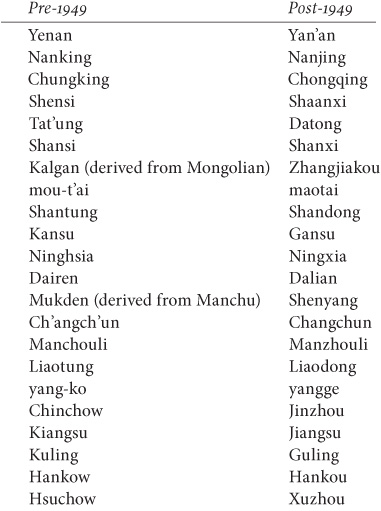
In the period covered in this memoir, roughly from the end of World War II to about 2005, three different systems of transcription of Chinese characters were used in published works and by foreigners residing in China. The oldest is Wade-Giles, developed in the mid-nineteenth century by a British scholar and a British diplomat, which was used in all books about China in English up until 1979 and which has been employed by the Republic of China for decades. The second is the Chinese Postal Map romanization system for place-names, which came into use in the late Qing dynasty (1644–1911) and was retained after the fall of the dynasty during the republican era on the mainland (1912–49). While based on Wade-Giles for postal purposes, it differs in a number of respects, including slightly different spellings that incorporate local Chinese dialects (e.g., Peking, Nanking) and also popular preexisting European names for places in China (e.g., Canton). The third and current system used on mainland China since the Communist takeover in October 1949 is the Hanyu Pinyin system, which is the official romanization of the People’s Republic of China and, since 1979, the most popular system employed in published works on China, including newspapers.
In this book, Wade-Giles and/or the Chinese Postal Map romanization systems are used for all references to Chinese terms and place-names prior to October 1949, while references after that date are, with a few exceptions, in Pinyin. Wade-Giles is also used throughout for all references to republican political and military leaders, while in the case of Communist officials (e.g., Mao Zedong) their names, for purposes of clarity, are rendered in Pinyin both before and after 1949. Below in their order of appearance in the text are major place-names and other Chinese terms in both their pre- and post-1949 rendering.

“Peking” is the name of China’s capital according to the Chinese Postal Map romanization and is used throughout the text for both pre- and post-1949 periods, as are “Peking University” and “Tsinghua University,” the official English renderings of these two institution names.
The Note on Chinese Language Romanization is used by courtesy of Professor Lawrence Sullivan, Adelphi University.